Experimental Study and Application of Controlled Low-Strength Materials in Trench Backfilling in Suqian City, China
Abstract
:1. Introduction
2. Materials and Methods
3. Experimental Design
3.1. Basic Physical Properties of the Excavated Soil
3.2. Materials
3.3. Flowability Tests
3.4. Compressive Strength Testing
4. Experimental Results
4.1. Flowability of CLSM
4.2. Compressive Strength of CLSM
4.2.1. Effects of Water Content
4.2.2. Effects of Cement Content
4.2.3. Effects of Curing Time
4.3. Optimisation of the Ratio of Materials
- (1)
- For 6% cement content,qu,3d = −78.555m + 833.97qu,7d = −96.795m + 1001qu,28d = −188.64m + 1833.1;
- (2)
- For 9% cement content,qu,3d = −319.25m + 1972.5qu,7d = −349.73m + 2194.8qu,28d = −364.93m + 2458.7;
- (3)
- For 12% cement content,qu,3d = −564.68m + 2720.8qu,7d = −709.13m + 3364.6where m is the water–cement ratio and , and are the compressive strength of the CLSM in the curing time of 3 days, 7 days, and 28 days, respectively. The linear relationship between the compressive strength and the water–cement ratio is broadly in good agreement with previous studies on CLSM summarized by Wang et al. [19]. However, it is worth noting that the above equations were obtained from the experimental data of the excavated soil in Suqian City with the water content between 40% and 50%. Therefore, care should be taken when using these equations in other cases.qu,28d = −609.13m + 3263.1
5. Engineering Practice and Discussion
5.1. Preparation of and Backfilling with CLSM
5.2. Quality Detection
5.3. Discussion
6. Conclusions
Author Contributions
Funding
Institutional Review Board Statement
Informed Consent Statement
Data Availability Statement
Conflicts of Interest
References
- Prum, S.; Jumnongpol, N.; Eamchotchawalit, C.; Kantiwattanakul, P.; Sooksatra, V.; Jarearnsiri, T.; Passananon, S. Guideline for Backfill Material Improvement for Water Supply Pipeline Construction on Bangkok Clay, Thailand. In Proceedings of the 4th World Congress on Civil, Structural, and Environmental Engineering (CSEE’19), Rome, Italy, 7–9 April 2019; pp. 7–9. [Google Scholar]
- Ling, T.C.; Kaliyavaradhan, S.K.; Poon, C.S. Global perspective on application of controlled low-strength material (CLSM) for trench backfilling–An overview. Constr. Build. Mater. 2018, 158, 535–548. [Google Scholar] [CrossRef]
- American Concrete Institute. ACI-229R, Controlled Low Strength Materials (Reproved 2005); American Concrete Institute: Farmington Hills, MI, USA, 2005. [Google Scholar]
- Fedrigo, W.; Nunez, W.P.; Visser, A.T. A review of full-depth reclamation of pavements with Portland cement: Brazil and abroad. Constr. Build. Mater. 2020, 262, 120540. [Google Scholar] [CrossRef]
- Linares-Unamunzaga, A.; Pérez-Acebo, H.; Rojo, M.; Gonzalo-Orden, H. Flexural strength prediction models for soil–cement from unconfined compressive strength at seven days. Materials 2019, 12, 387. [Google Scholar] [CrossRef] [PubMed]
- Fedrigo, W.; Núñez, W.P.; López, M.A.C.; Kleinert, T.R.; Ceratti, J.A.P. A study on the resilient modulus of cement-treated mixtures of RAP and aggregates using indirect tensile, triaxial and flexural tests. Constr. Build. Mater. 2018, 171, 161–169. [Google Scholar] [CrossRef]
- Naik, T.R.; Singh, S.S. Permeability of flowable slurry materials containing foundry sand and fly ash. J. Geotech. Geoenviron. Eng. 1997, 123, 446–452. [Google Scholar] [CrossRef]
- Dockter, B.A. Comparison of dry scrubber and class c fly ash in controlled lowstrength materials (CLSM) applications. In The Design and Application of Controlled Low-Strength Materials (Flowable Fill), ASTM STP 1331; Howard, A.K., Hitch, J.L., Eds.; American Society for Testing and Materials: West Conshohocken, PA, USA, 1998; pp. 13–26. [Google Scholar]
- Kaneshiro, J.; Navin, S.; Wendel, L.; Snowden, H. Controlled low strength material for pipeline backfill—Specifications, case histories and lessons learned. In Pipelines 2001: Advances in Pipelines Engineering and Construction; American Society of Civil Engineers: Reston, VA, USA, 2001; pp. 1–13. [Google Scholar]
- Finney, A.J.; Shorey, E.F.; Anderson, J. Use of native soil in place of aggregate in controlled low strength material (CLSM). In Pipelines 2008: Pipeline Asset Management: Maximizing Performance of our Pipeline Infrastructure; American Society of Civil Engineers: Reston, VA, USA, 2008; pp. 1–13. [Google Scholar]
- Dalal, P.H.; Patil, M.; Iyer, K.K.; Dave, T.N. Sustainable controlled low strength material from waste materials for infrastructure applications: State-of-the-art. J. Environ. Manag. 2023, 342, 118284. [Google Scholar] [CrossRef] [PubMed]
- Kaliyavaradhan, S.K.; Ling, T.C.; Guo, M.Z. Upcycling of wastes for sustainable controlled low-strength material: A review on strength and excavatability. Environ. Sci. Pollut. Res. 2022, 29, 16799–16816. [Google Scholar] [CrossRef] [PubMed]
- Blanco, A.; Pujadas, P.; Cavalaro, S.H.P.; Aguado, A. Methodology for the design of controlled low-strength materials. Appl. Backfill Narrow Trenches. Constr. Build. Mater. 2014, 72, 23–30. [Google Scholar] [CrossRef]
- Fauzi, M.A.; Arshad, M.F.; Nor, N.M.; Ghazali, E. Modeling and optimization of properties for unprocessed-fly ash (u-FA) controlled low-strength material as backfill materials. Clean. Eng. Technol. 2022, 6, 100395. [Google Scholar] [CrossRef]
- Ibrahim, M.; Rahman, M.K.; Najamuddin, S.K.; Alhelal, Z.S.; Acero, C.E. A review on utilization of industrial by-products in the production of controlled low strength materials and factors influencing the properties. Constr. Build. Mater. 2022, 325, 126704. [Google Scholar] [CrossRef]
- Kuo, W.T.; Wang, H.Y.; Shu, C.Y.; Su, D.S. Engineering properties of controlled low-strength materials containing waste oyster shells. Constr. Build. Mater. 2013, 46, 128–133. [Google Scholar] [CrossRef]
- Liu, H.; Xiao, Y.; Liu, K.; Zhu, Y.; Zhang, P. Numerical simulation on backfilling of buried pipes using controlled low strength materials. Appl. Sci. 2022, 12, 6901. [Google Scholar] [CrossRef]
- Türkel, S.E.L.Ç.U.K. Strength properties of fly ash based controlled low strength materials. J. Hazard. Mater. 2007, 147, 1015–1019. [Google Scholar] [CrossRef] [PubMed]
- Wang, C.; Li, Y.; Wen, P.; Zeng, W.; Wang, X. A comprehensive review on mechanical properties of green controlled low strength materials. Constr. Build. Mater. 2023, 363, 129611. [Google Scholar] [CrossRef]
- JTG 3430—2020; China Standard: Regulations for Highway Geotechnical Testing. National Standards of the People’s Republic of China: Bejing, China, 2020.
- Khadka, S.D.; Okuyucu, O.; Jayawickrama, P.W.; Senadheera, S. Controlled low strength materials (CLSM) activated with alkaline solution: Flowability, setting time and microstructural characteristics. Case Stud. Constr. Mater. 2023, 18, e01892. [Google Scholar] [CrossRef]
- Wan, X.; Ding, J.; Jiao, N.; Zhang, S.; Wang, J.; Guo, C. Preparing controlled low strength materials (CLSM) using excavated waste soils with polycarboxylate superplasticizer. Environ. Earth Sci. 2023, 82, 214. [Google Scholar] [CrossRef]
- Tran, T.Q.; Kim, Y.S.; Dang, L.C.; Do, T.M. A state-of-the-art review on the utilization of new green binders in the production of controlled low-strength materials. Constr. Build. Mater. 2023, 393, 132078. [Google Scholar] [CrossRef]
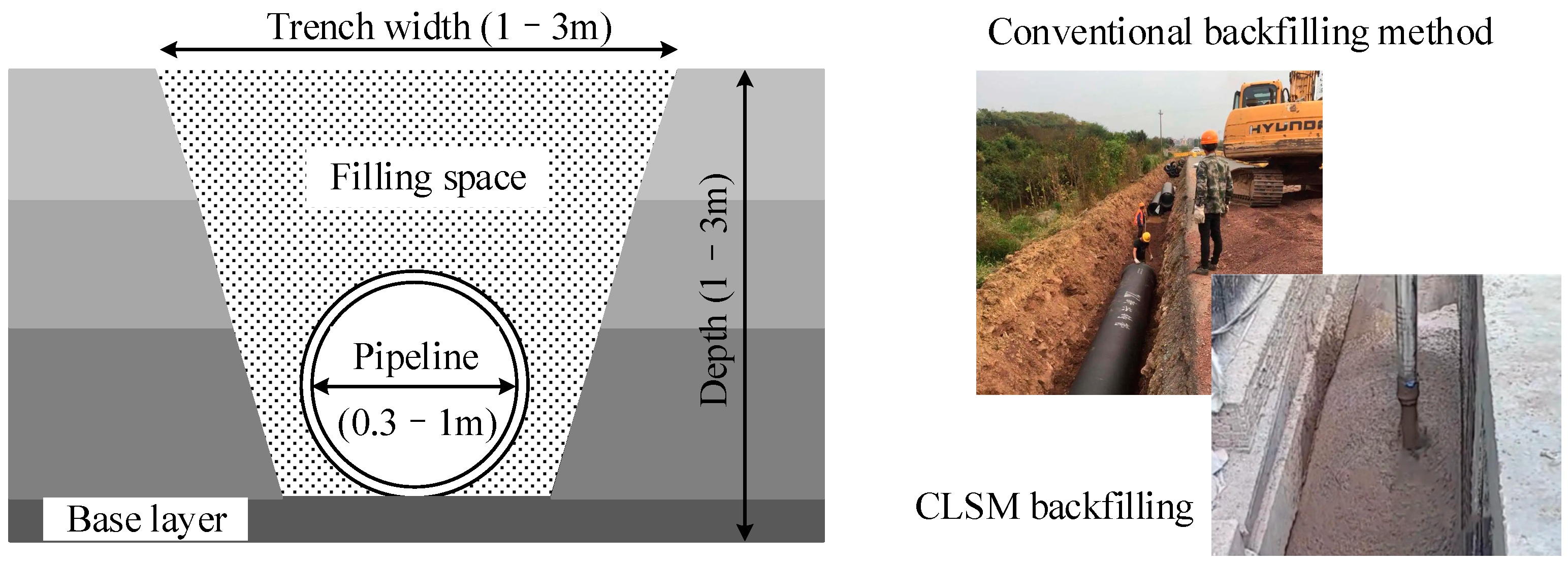


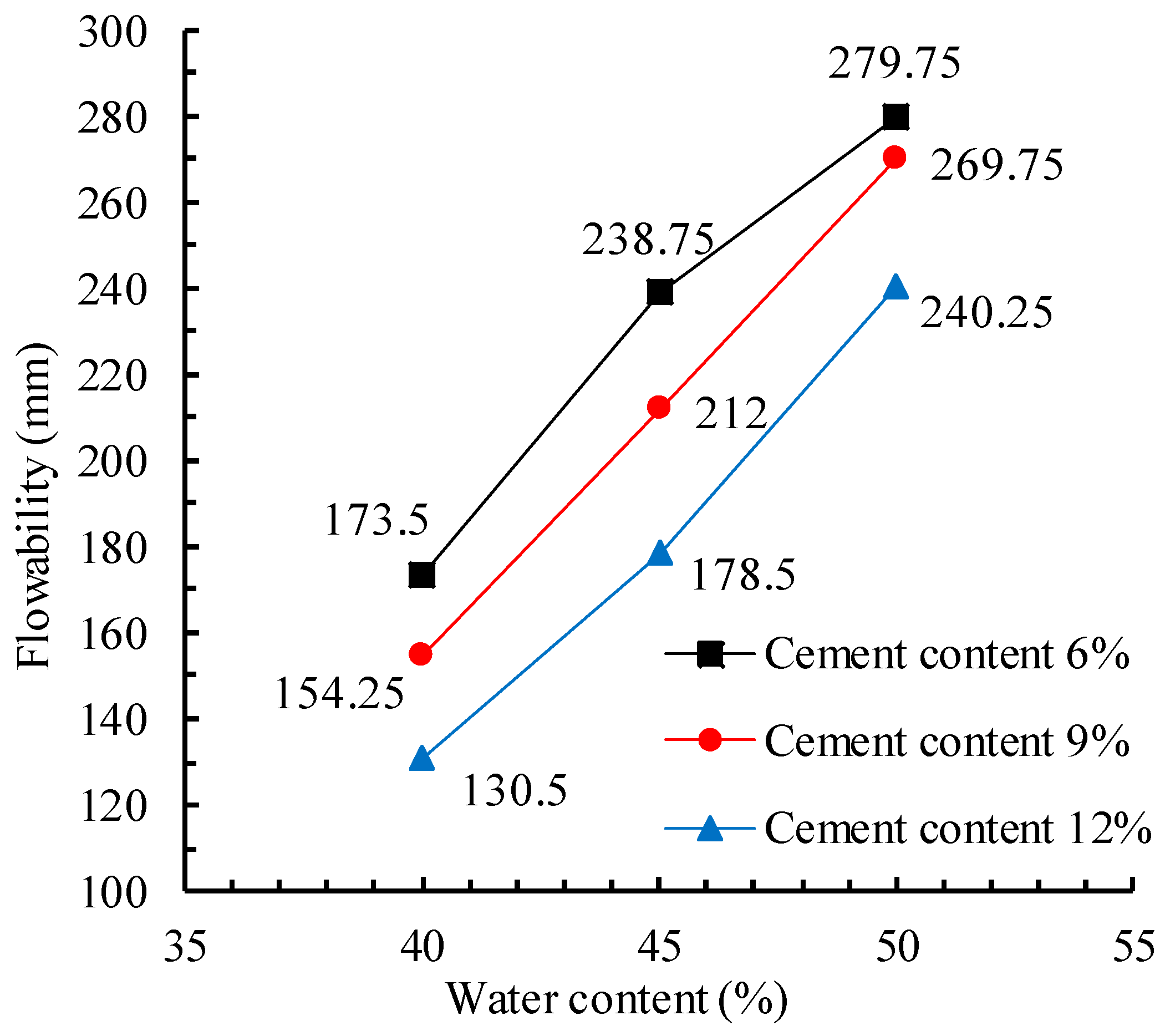
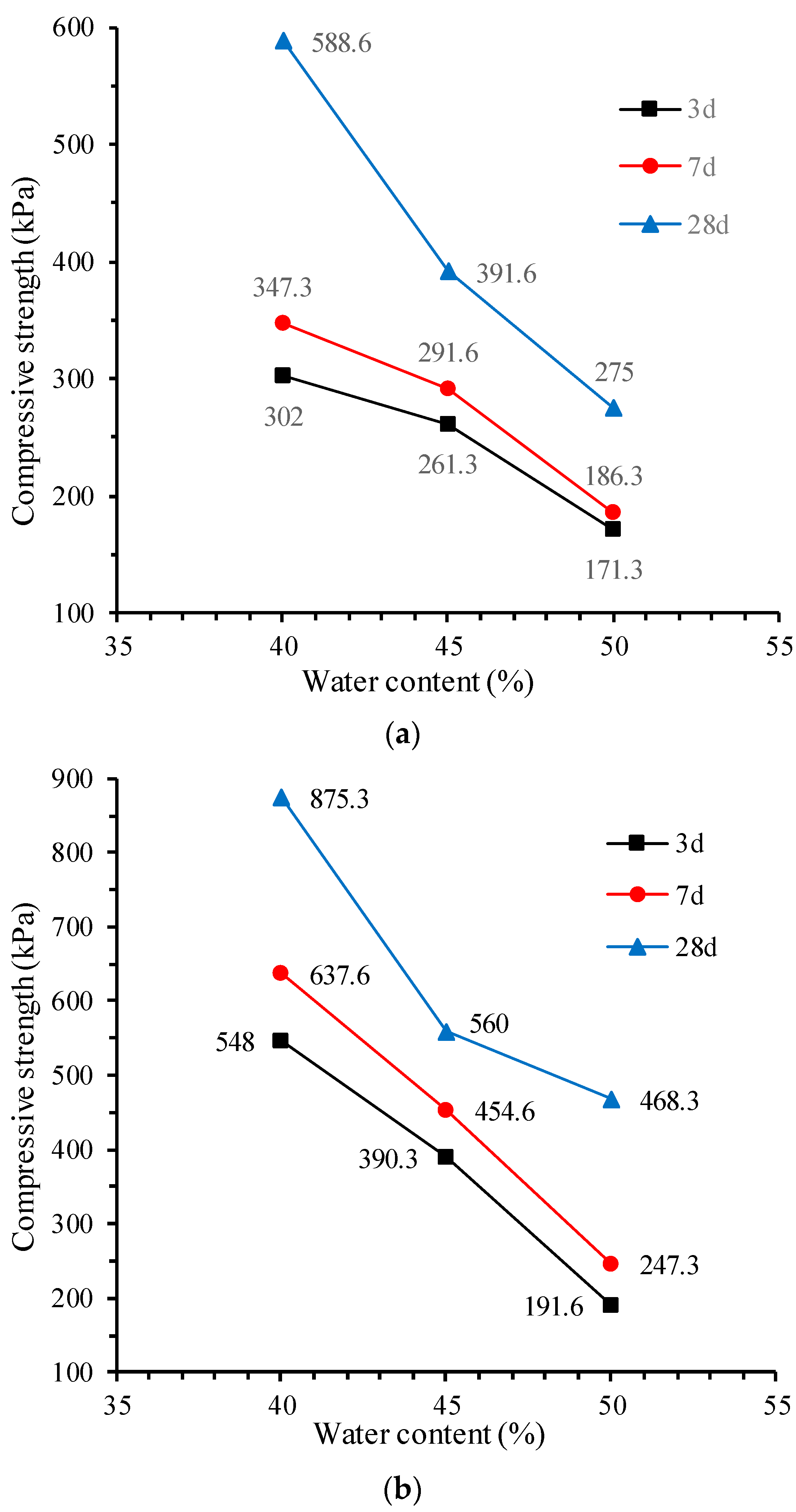

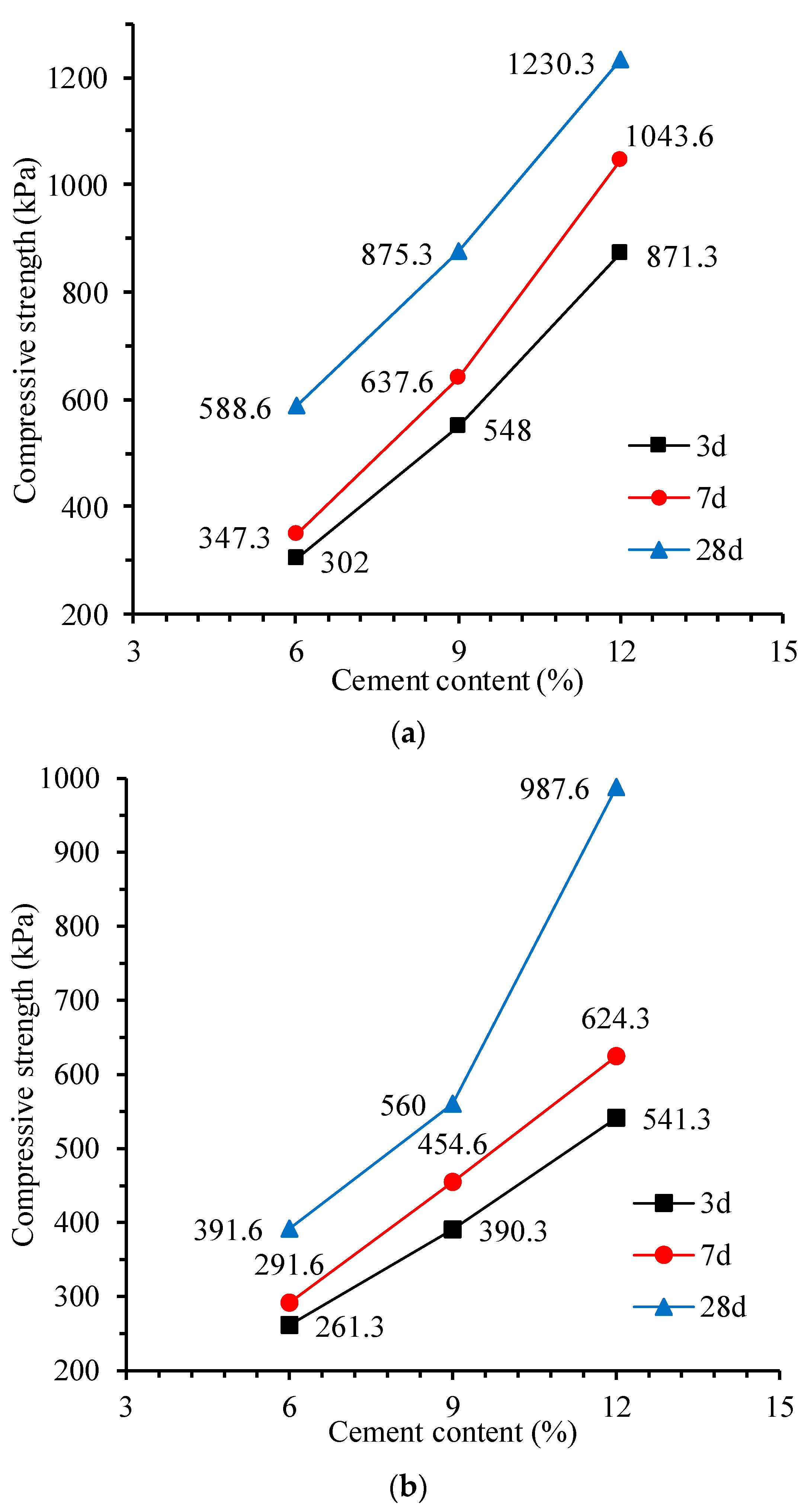
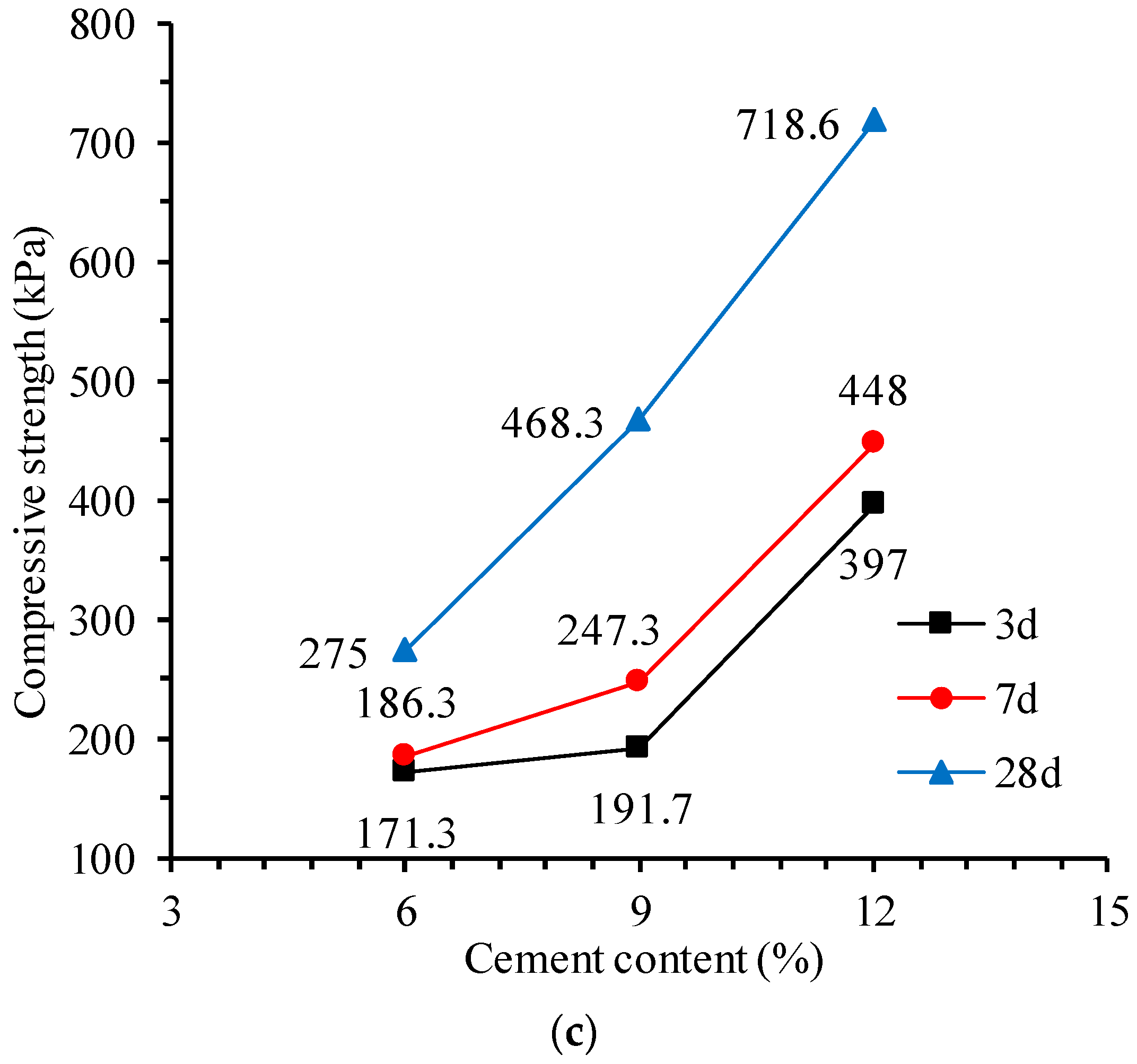
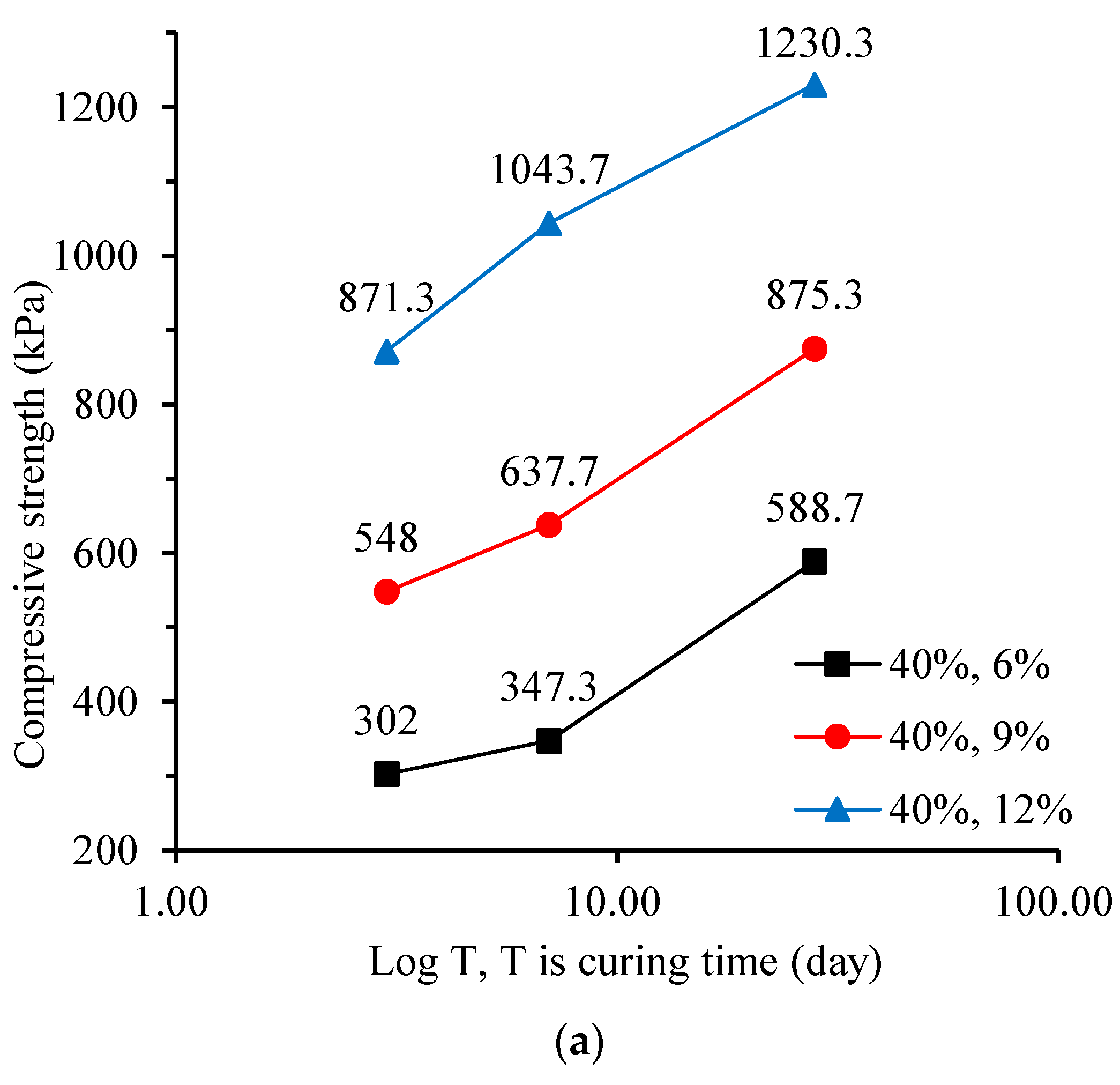


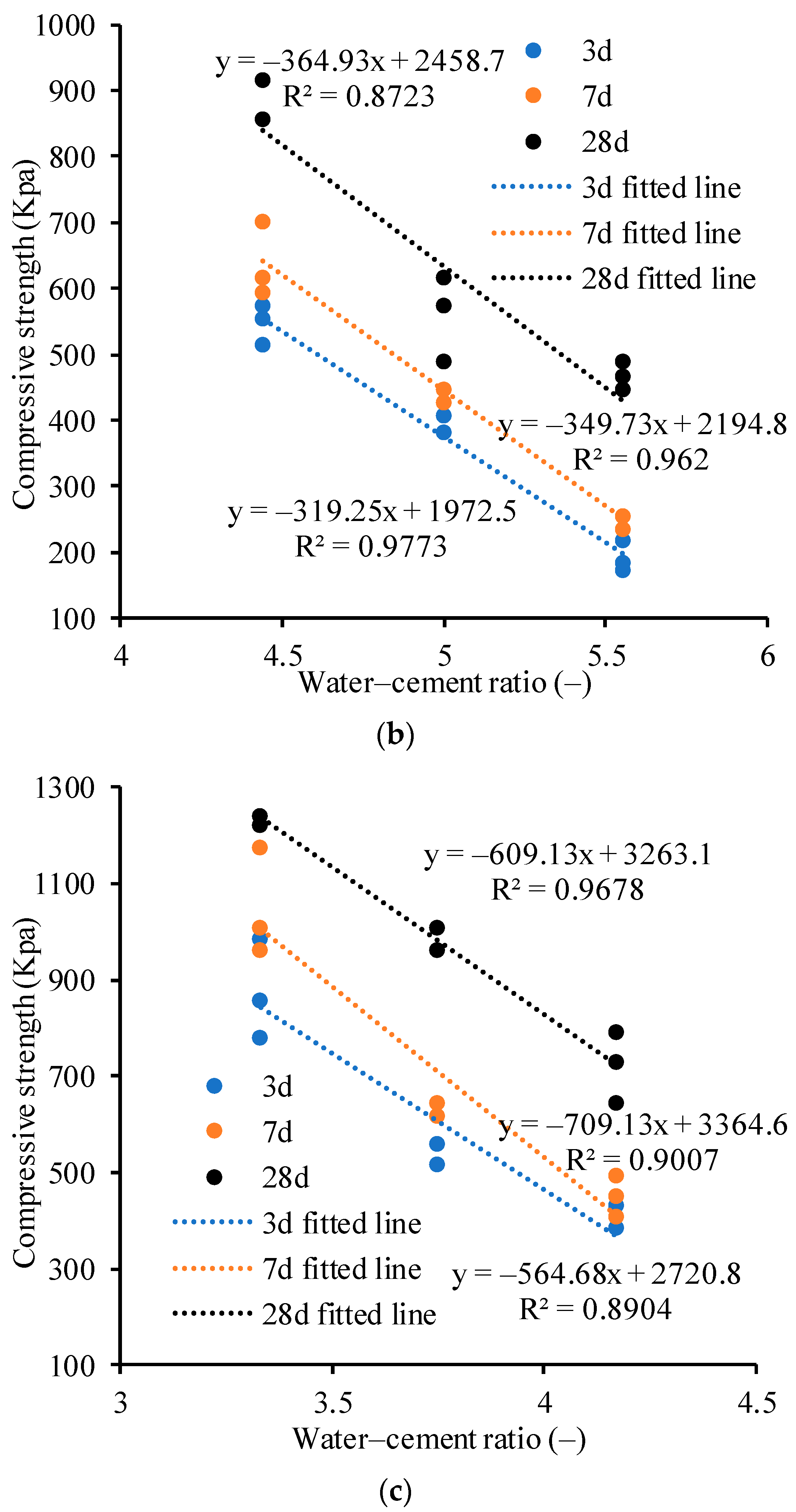


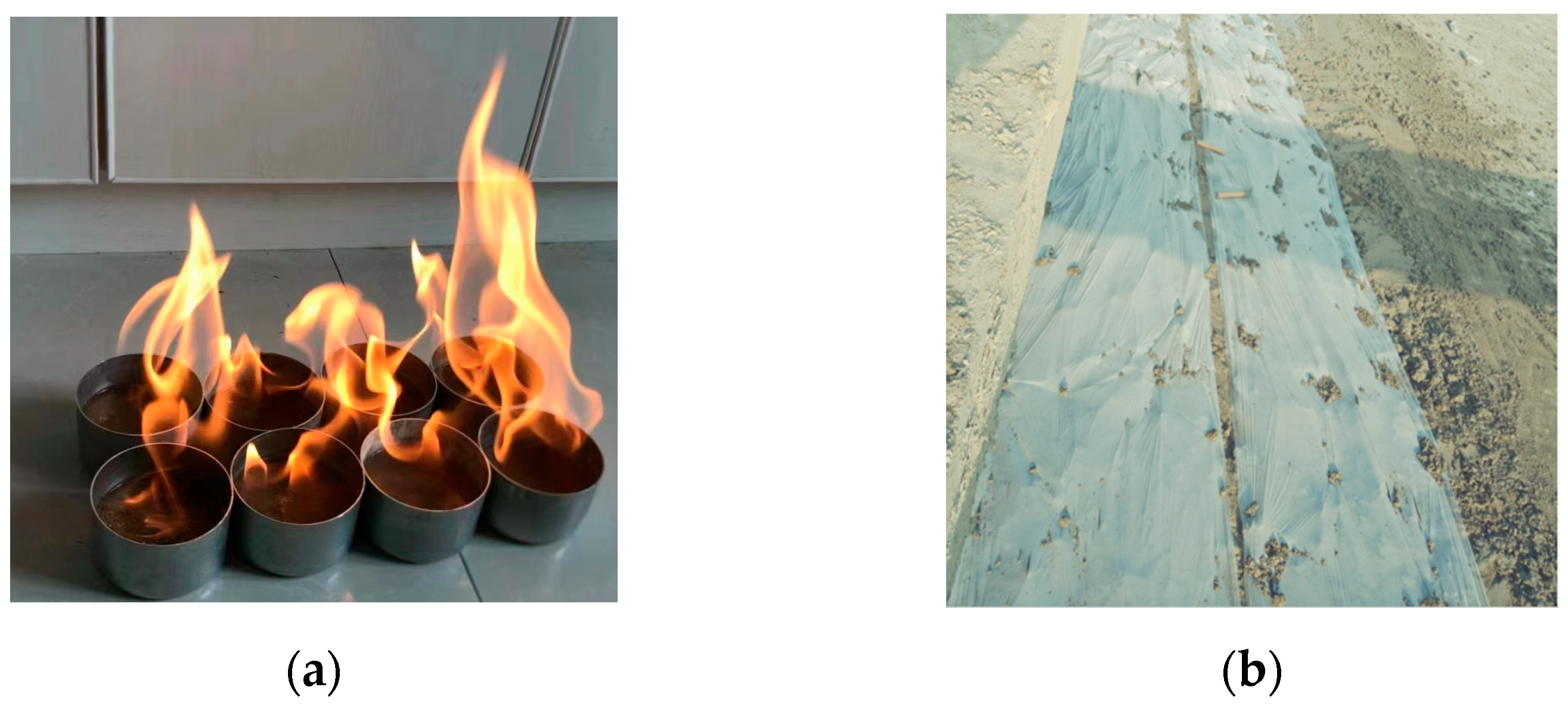
| Particle (mm) | >0.25 | 0.25~0.075 | 0.075~0.005 | <0.005 |
| Percentage (%) | 11.16 | 18.6 | 57.23 | 13.01 |
| Cement Content (%) | Water Content (%) | Curing Time (%) |
|---|---|---|
| 6 | 40, 45, 50 | 3, 7, 28 |
| 9 | 40, 45, 50 | 3, 7, 28 |
| 12 | 40, 45, 50 | 3, 7, 28 |
| Water (%) | Cement (%) | 3 Days | 7 Days | 28 Days | Flowability |
|---|---|---|---|---|---|
| qu (KPa), RSD (%) | qu (KPa), RSD (%) | qu (KPa), RSD (%) | Value (mm), RSD (%) | ||
| 40 | 6 | 302, 1.00 | 347.3, 6.81 | 588.6, 4.02 | 173.5, 6.56 |
| 9 | 548, 5.67 | 637.6, 8.89 | 875.3, 4.02 | 154.25, 4.31 | |
| 12 | 871.3, 9.98 | 1043.6, 9.79 | 1230.3, 0.94 | 130.5, 4.74 | |
| 45 | 6 | 261.3, 9.06 | 291.6, 4.95 | 391.6, 9.49 | 238.75, 1.05 |
| 9 | 390.3, 3.70 | 454.6, 6.94 | 560, 9.57 | 212, 4.74 | |
| 12 | 541.3, 4.37 | 624.3, 2.31 | 987.6, 2.69 | 178.5, 6.51 | |
| 50 | 6 | 171.3, 4.46 | 186.3, 10.39 | 275, 1.08 | 279.75, 1.02 |
| 9 | 191.7, 10.62 | 247.3, 4.67 | 468.3, 4.38 | 269.75, 1.30 | |
| 12 | 397, 6.54 | 448, 9.15 | 718.6, 10.33 | 240.25, 1.04 |
Disclaimer/Publisher’s Note: The statements, opinions and data contained in all publications are solely those of the individual author(s) and contributor(s) and not of MDPI and/or the editor(s). MDPI and/or the editor(s) disclaim responsibility for any injury to people or property resulting from any ideas, methods, instructions or products referred to in the content. |
© 2024 by the authors. Licensee MDPI, Basel, Switzerland. This article is an open access article distributed under the terms and conditions of the Creative Commons Attribution (CC BY) license (https://creativecommons.org/licenses/by/4.0/).
Share and Cite
Xu, J.; Luo, Q.; Tang, Y.; Zeng, Z.; Liao, J. Experimental Study and Application of Controlled Low-Strength Materials in Trench Backfilling in Suqian City, China. Materials 2024, 17, 775. https://doi.org/10.3390/ma17040775
Xu J, Luo Q, Tang Y, Zeng Z, Liao J. Experimental Study and Application of Controlled Low-Strength Materials in Trench Backfilling in Suqian City, China. Materials. 2024; 17(4):775. https://doi.org/10.3390/ma17040775
Chicago/Turabian StyleXu, Jingmin, Qiwu Luo, Yong Tang, Zhibo Zeng, and Jun Liao. 2024. "Experimental Study and Application of Controlled Low-Strength Materials in Trench Backfilling in Suqian City, China" Materials 17, no. 4: 775. https://doi.org/10.3390/ma17040775





